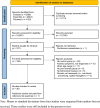Cognitive Functioning in Youth with Anxiety Disorders: A Systematic Review
- PMID: 38829508
- PMCID: PMC11222226
- DOI: 10.1007/s10567-024-00480-9
Cognitive Functioning in Youth with Anxiety Disorders: A Systematic Review
Abstract
Anxiety disorders are disorders involving cognition. Research on cognition in youth with anxiety can focus on cognitive content (e.g., self-talk) as well cognitive functioning. The present review examines domains of cognitive functioning (i.e., episodic memory, language, attention, executive functioning, motor skills, and visual functioning) in youth diagnosed with an anxiety disorder. A database search of Embase, PsycINFO, and PubMed yielded 28 studies that met inclusion criteria of youth aged 17 years or younger, a sample diagnosed with a principal anxiety disorder and a comparison sample of controls, a comparison between those samples, and use of a behavioral measure of neuropsychological performance. Findings did not identify any cognitive functioning strengths for anxious youth. Deficits were found in two domains (i.e., receptive language and motor skills) whereas no deficits were found in attention, visuospatial skills and one domain of executive functioning (i.e., inhibition). Most domains had mixed findings. Additional analysis indicated that anxiety disorders in youth are not associated with diminished IQ. Directions for future research are identified including (a) the prioritization of studies with larger, representative samples (b) the role of cognitive functioning as a predictor of anxiety treatment outcome (c) the examination of the effect of treatment on cognitive performance, and (d) the course of anxiety and potential impairment in cognitive functioning.
Keywords: Anxiety; Attention; Children and adolescents; Executive functioning; Language; Memory.
© 2024. The Author(s).
Conflict of interest statement
Mr. Rabner and Ms. Ney report no competing interests.
Similar articles
-
Technological aids for the rehabilitation of memory and executive functioning in children and adolescents with acquired brain injury.Cochrane Database Syst Rev. 2016 Jul 1;7(7):CD011020. doi: 10.1002/14651858.CD011020.pub2. Cochrane Database Syst Rev. 2016. PMID: 27364851 Free PMC article.
-
Parent training interventions for Attention Deficit Hyperactivity Disorder (ADHD) in children aged 5 to 18 years.Cochrane Database Syst Rev. 2011 Dec 7;2011(12):CD003018. doi: 10.1002/14651858.CD003018.pub3. Cochrane Database Syst Rev. 2011. PMID: 22161373 Free PMC article.
-
Occupational therapy for cognitive impairment in stroke patients.Cochrane Database Syst Rev. 2022 Mar 29;3(3):CD006430. doi: 10.1002/14651858.CD006430.pub3. Cochrane Database Syst Rev. 2022. PMID: 35349186 Free PMC article.
-
Interventions for preventing and ameliorating cognitive deficits in adults treated with cranial irradiation.Cochrane Database Syst Rev. 2022 Nov 25;11(11):CD011335. doi: 10.1002/14651858.CD011335.pub3. Cochrane Database Syst Rev. 2022. PMID: 36427235 Free PMC article.
-
Education support services for improving school engagement and academic performance of children and adolescents with a chronic health condition.Cochrane Database Syst Rev. 2023 Feb 8;2(2):CD011538. doi: 10.1002/14651858.CD011538.pub2. Cochrane Database Syst Rev. 2023. PMID: 36752365 Free PMC article.
Cited by
-
Memory Functions in Obsessive-Compulsive Disorder.Brain Sci. 2025 May 7;15(5):492. doi: 10.3390/brainsci15050492. Brain Sci. 2025. PMID: 40426663 Free PMC article. Review.
References
-
- American Psychiatric Association . Diagnostic and statistical manual of mental disorders. American Psychiatric Press; 2013.
-
- Benton Sivan, A. (1991). Benton visual retention test, 5th edn. 10.1037/t14985-000
Publication types
MeSH terms
LinkOut - more resources
Full Text Sources
Medical
Miscellaneous


